Recent Posts
Protecting Your Home from Fire Damage in Salt Lake City, UT
7/20/2024 (Permalink)
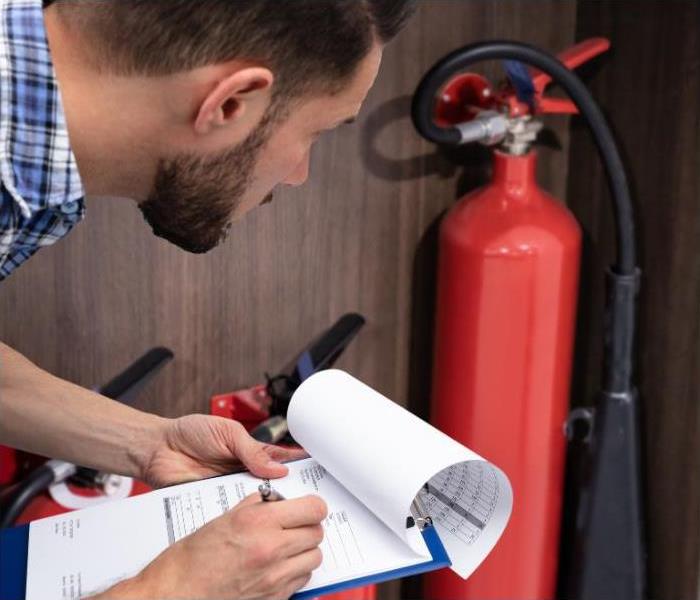 Shielding Your Home from Fire Damage in Salt Lake City, UT
Shielding Your Home from Fire Damage in Salt Lake City, UT
Fire safety is a crucial concern for homeowners everywhere, including Salt Lake City, UT. Fires can occur unexpectedly, and the resulting damage can be devastating. Implementing proactive measures to protect your home from fire damage is essential to safeguard your property and the well-being of your loved ones. Here are some comprehensive tips to help you fireproof your residence and ensure a safer living environment.
1. Install Smoke Alarms and Fire Extinguishers
Smoke Alarms: Smoke alarms are your first line of defense against a fire. Install smoke alarms on every level of your home, inside each bedroom, and outside sleeping areas. Test them monthly and replace batteries at least once a year. Consider interconnected smoke alarms, so when one sounds, they all do.
Fire Extinguishers: Place fire extinguishers in key areas of your home, such as the kitchen, garage, and near fireplaces. Learn how to use them properly and ensure all household members know where they are located and how to operate them.
2. Create a Fire Escape Plan
Developing and practicing a fire escape plan is crucial. Identify at least two exits from each room, and ensure windows and doors open easily. Designate a meeting place outside your home where everyone will gather in the event of a fire. Practice the plan regularly, including at night, to ensure everyone knows what to do.
3. Maintain Electrical Safety
Inspect Wiring: Faulty wiring is a leading cause of house fires. Have a licensed electrician inspect your home’s electrical system, especially if your home is older. Look out for warning signs such as flickering lights, buzzing outlets, and frequently tripped circuit breakers.
Avoid Overloading Circuits: Avoid plugging too many devices into one outlet or extension cord. Use power strips with surge protectors and distribute electrical load evenly.
Replace Damaged Cords: Regularly check cords for signs of wear and tear. Replace frayed or damaged cords immediately to prevent electrical fires.
4. Practice Safe Cooking Habits
The kitchen is a common area where fires start. Follow these safety tips:
Stay in the Kitchen: Never leave cooking food unattended, especially when frying, grilling, or broiling.
Keep Flammable Items Away: Keep towels, paper products, and other flammable items away from the stove and other heat sources.
Clean Regularly: Grease buildup can ignite easily. Clean your stovetop, oven, and range hood regularly to prevent grease fires.
5. Heat Your Home Safely
Salt Lake City’s cold winters mean heating your home is a necessity. Follow these guidelines to do so safely:
Space Heaters: Use space heaters with automatic shut-off features and keep them at least three feet away from flammable materials. Never leave a space heater unattended.
Fireplaces and Wood Stoves: Have your chimney inspected and cleaned annually. Use a fireplace screen to prevent sparks from escaping, and never leave a fire unattended.
6. Install Sprinkler Systems
Home fire sprinkler systems can control or extinguish a fire before the fire department arrives. Consider installing a sprinkler system, especially if you are building a new home or renovating. They provide an extra layer of protection and can significantly reduce fire damage.
7. Store Flammable Materials Properly
Keep flammable materials such as gasoline, paint, and cleaning supplies in appropriate containers and away from heat sources. Store them in a well-ventilated area, preferably outside your living space, such as in a garage or shed.
8. Maintain Your Yard
Proper yard maintenance can help prevent the spread of fires, especially during the dry summer months in Salt Lake City.
Clear Debris: Remove dead leaves, branches, and other debris from your yard, roof, and gutters.
Trim Trees and Bushes: Keep trees and bushes trimmed, especially those close to your home. Maintain a safe distance between tree branches and your roof.
Fire-Resistant Landscaping: Consider using fire-resistant plants and materials in your landscaping. Gravel, stone, and well-maintained lawns are less likely to catch fire than mulch or dried grass.
9. Be Mindful of Candles
Candles can create a cozy atmosphere but pose a fire risk if not used carefully.
Never Leave Unattended: Always blow out candles when leaving a room or going to bed.
Use Candle Holders: Place candles in sturdy holders that won’t tip over and keep them away from flammable materials.
Consider Alternatives: Battery-operated candles provide a safe alternative, offering the same ambiance without the fire risk.
10. Educate Your Family
Ensuring that every family member understands fire safety is paramount. Teach children about the dangers of fire and how to respond in case of an emergency. Practice fire drills regularly and discuss the importance of staying low to the ground to avoid smoke inhalation during an escape.
11. Regular Home Maintenance
Regular home maintenance can prevent fires from starting:
Clean Dryer Vents: Lint buildup in dryer vents can ignite. Clean the lint filter after every use and have the venting system inspected and cleaned annually.
Inspect HVAC Systems: Have your heating, ventilation, and air conditioning systems inspected regularly. Ensure filters are clean and replaced as needed.
Test and Maintain: Regularly test and maintain all fire prevention and detection equipment, including smoke alarms, fire extinguishers, and sprinkler systems.
12. Stay Informed
Stay updated on local fire hazards and weather conditions. Salt Lake City can experience dry spells, increasing fire risk. Monitor local news and weather reports, and follow any fire safety advisories issued by local authorities.
Taking proactive steps to protect your home from fire damage is essential for the safety and security of your family and property. By implementing these tips and maintaining a vigilant attitude towards fire safety, you can significantly reduce the risk of a fire in your home. Remember, preparation and education are key components in safeguarding your residence against the devastating effects of fire. Stay safe and fireproof your home to ensure a secure and protected living environment in Salt Lake City, UT.
Restoring Hope After the Storm: SERVPRO’s Storm Damage Restoration Process in Salt Lake City, UT
7/1/2024 (Permalink)
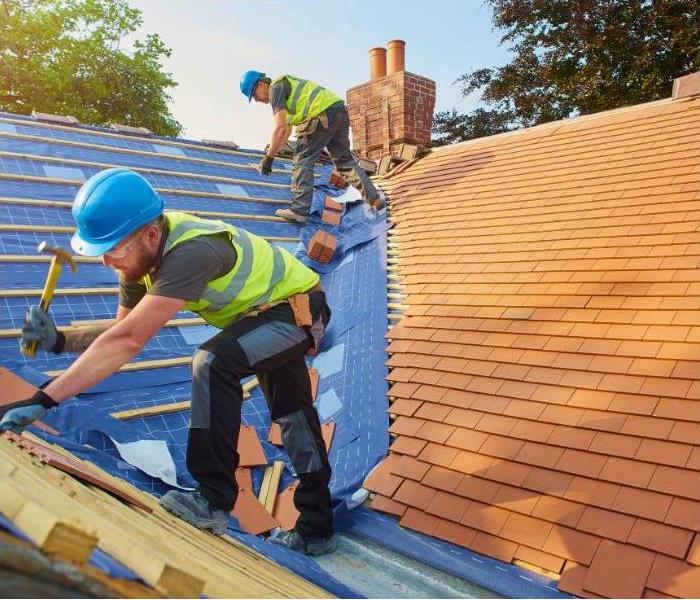 Storm Damage Restoration Process in Salt Lake City, UT
Storm Damage Restoration Process in Salt Lake City, UT
Storms can wreak havoc on communities, causing extensive damage to homes and businesses. Salt Lake City, UT, is no stranger to such events, where powerful storms often leave a trail of destruction. In these challenging times, the need for prompt and effective restoration services becomes paramount. SERVPRO, a leader in the restoration industry, offers a comprehensive storm damage restoration process that brings homes and businesses back to their pre-storm condition. Let’s delve into the detailed steps SERVPRO takes to restore storm-damaged properties in Salt Lake City.
Step 1: Emergency Contact
The restoration process begins the moment you call SERVPRO. Available 24/7, their emergency contact line ensures that help is always within reach. The SERVPRO representative gathers essential information about the damage, allowing them to dispatch a highly trained response team to your location quickly. This immediate response is crucial in mitigating further damage and setting the stage for a successful restoration.
Step 2: Inspection and Damage Assessment
Once on-site, SERVPRO’s technicians conduct a thorough inspection of the property. They assess the extent of the storm damage, checking for issues such as water intrusion, structural damage, and compromised roofing. This step involves using advanced tools and technology, including moisture meters and infrared cameras, to detect hidden moisture and other underlying problems. The findings from this assessment help in formulating a tailored restoration plan that addresses all aspects of the damage.
Step 3: Board-Up and Roof-Tarp Service
Storms often leave properties vulnerable to further damage from the elements or unauthorized access. To protect your home or business, SERVPRO provides board-up services for broken windows, doors, and compromised walls. Additionally, they offer roof-tarp services to cover damaged roofing areas, preventing water from entering the property. These temporary measures are essential for securing the property and stabilizing the situation before more extensive restoration work can begin.
Step 4: Water Removal and Drying
Water damage is a common consequence of storms, leading to potential issues like mold growth and structural deterioration. SERVPRO’s team uses powerful pumps and industrial-grade wet/dry vacuums to remove standing water from the affected areas. Once the bulk of the water is extracted, the drying process begins. Using high-speed air movers and dehumidifiers, SERVPRO ensures that all moisture is thoroughly removed from walls, floors, and other materials. This step is critical in preventing mold growth and further structural damage.
Step 5: Cleaning and Sanitizing
Storm damage often brings in contaminants and debris, making thorough cleaning and sanitization a vital part of the restoration process. SERVPRO’s technicians clean all restorable items and structures that have been affected by the storm. This includes a variety of cleaning techniques to restore belongings to their pre-damage condition. Moreover, they use antimicrobial treatments to prevent mold and mildew from forming. Air scrubbers and fogging equipment may also be utilized to remove odors and improve air quality in the property.
Step 6: Restoration and Repair
Restoration is the final step in SERVPRO’s comprehensive storm damage restoration process. This phase involves repairing and rebuilding damaged structures to return your property to its pre-storm condition. Whether it’s minor repairs like replacing drywall and installing new carpet, or major reconstruction projects, SERVPRO has the expertise to handle it all. They coordinate with insurance companies to streamline the claims process, ensuring that you receive the necessary support for your restoration efforts.
The SERVPRO Advantage in Salt Lake City
What sets SERVPRO apart in Salt Lake City is their commitment to excellence and customer satisfaction. Their team of professionals is highly trained in storm damage restoration, equipped with the latest technology and techniques to handle any level of damage. SERVPRO’s rapid response time, meticulous attention to detail, and comprehensive restoration services make them a trusted partner in the aftermath of a storm.
Community Support and Education
Beyond their technical capabilities, SERVPRO plays a crucial role in supporting the Salt Lake City community. They offer educational resources and workshops to help residents and business owners understand the steps they can take to minimize storm damage. By fostering a sense of preparedness and resilience, SERVPRO empowers the community to face future storms with greater confidence.
Real-Life Success Stories
The impact of SERVPRO’s restoration services can be seen in countless success stories across Salt Lake City. From helping a family return to their storm-ravaged home to restoring a local business and preventing significant financial loss, SERVPRO’s work makes a tangible difference in people’s lives. These stories highlight the importance of professional restoration services in the wake of a disaster and serve as a testament to SERVPRO’s dedication and expertise.
Storm damage can be a devastating experience, but with the right support, recovery is not only possible but also efficient and effective. SERVPRO’s comprehensive storm damage restoration process in Salt Lake City, UT, provides a lifeline to those affected by severe weather. From immediate emergency response to the final touches of restoration, SERVPRO stands by your side, ensuring that your property is restored to its former glory. Their dedication to excellence, advanced technology, and compassionate customer service make them an invaluable asset in the face of storm-related challenges.
Navigating Nature: 5 Essential Tips to Reduce Flooding Risks in Salt Lake City, UT
5/18/2024 (Permalink)
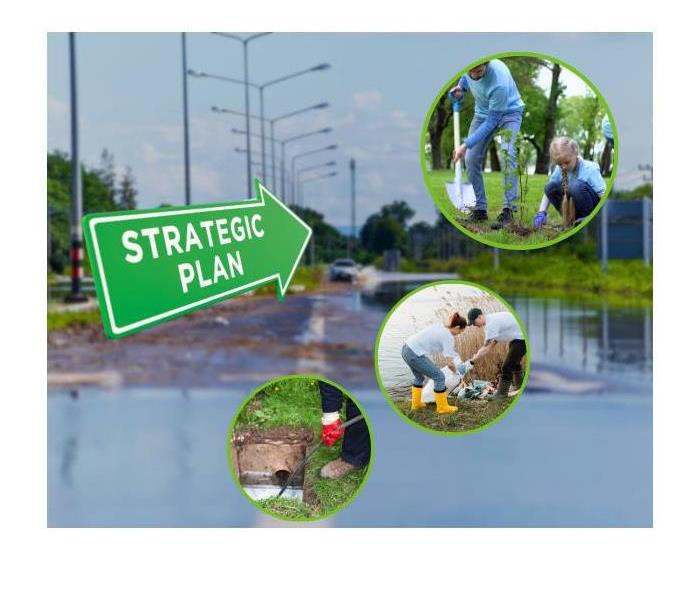 Strategies for a sustainable future in Salt Lake City.
Strategies for a sustainable future in Salt Lake City.
Salt Lake City, nestled against the backdrop of the stunning Wasatch Mountains, is a vibrant metropolis renowned for its outdoor recreational opportunities, cultural attractions, and thriving economy. However, like many urban centers, it faces the perennial challenge of managing flooding risks, particularly during the spring thaw or heavy rainstorms. With a proactive approach and strategic measures, residents and authorities can mitigate these risks and safeguard their communities. Here are five essential tips to reduce flooding risks in Salt Lake City:
1. Enhance Stormwater Management Infrastructure:
Effective stormwater management infrastructure is the backbone of flood risk reduction efforts. Salt Lake City can invest in upgrading its stormwater drainage systems, including culverts, retention ponds, and storm sewers. By enhancing the capacity and efficiency of these systems, the city can better handle excess rainwater and snowmelt, reducing the likelihood of flooding in low-lying areas and residential neighborhoods.
Additionally, implementing green infrastructure solutions such as rain gardens, permeable pavements, and vegetated swales can help absorb and filter stormwater runoff, reducing the strain on traditional drainage systems. These nature-based approaches not only mitigate flooding risks but also enhance urban biodiversity, improve air and water quality, and create attractive green spaces for residents to enjoy.
2. Promote Sustainable Land Use Planning:
Land use planning plays a critical role in flood risk management. Salt Lake City can adopt sustainable land use practices that prioritize floodplain management, limit development in high-risk areas, and promote the preservation of natural flood buffers such as wetlands and riparian zones. Zoning regulations should be updated to ensure that new construction projects adhere to flood-resistant building standards and elevation requirements.
Furthermore, incentivizing the retrofitting of existing buildings with flood-proofing measures, such as elevated foundations, waterproof barriers, and sump pump systems, can help mitigate flood damage and protect property and infrastructure during extreme weather events. Collaborating with developers, community stakeholders, and environmental organizations is essential to fostering a resilient built environment that can withstand flooding impacts.
3. Foster Public Awareness and Education:
Empowering residents with knowledge and resources is key to building a flood-resilient community. Salt Lake City can launch public awareness campaigns to educate citizens about flood risks, emergency preparedness strategies, and sustainable water management practices. This can include distributing informational materials, hosting community workshops, and leveraging digital platforms to disseminate relevant information.
Schools, universities, and community centers can also play a vital role in educating the public about the importance of flood safety and environmental stewardship. By fostering a culture of preparedness and resilience, Salt Lake City can empower individuals and families to take proactive measures to protect themselves, their properties, and their neighborhoods from flooding hazards.
4. Implement Nature-Based Flood Control Measures:
Nature-based flood control measures harness the power of ecosystems to reduce flood risks and enhance resilience. Salt Lake City can invest in natural infrastructure projects such as floodplain restoration, streambank stabilization, and watershed management initiatives. Restoring natural floodplain habitats not only provides valuable habitat for wildlife but also helps slow down and absorb floodwaters, reducing downstream flooding impacts.
Additionally, preserving and enhancing riparian vegetation along waterways can help stabilize soil, prevent erosion, and improve water quality. Strategic reforestation efforts in upstream areas can also help regulate streamflow and reduce the risk of flash floods during heavy rainfall events. By integrating nature-based solutions into flood risk management strategies, Salt Lake City can achieve multiple co-benefits for both people and the environment.
5. Foster Regional Collaboration and Resilience:
Flood risk knows no boundaries, and effective mitigation requires collaboration at the regional level. Salt Lake City can work closely with neighboring municipalities, county governments, state agencies, and federal partners to develop coordinated flood risk management plans and emergency response protocols. Sharing data, resources, and expertise can enhance the effectiveness of flood forecasting, early warning systems, and evacuation procedures.
Furthermore, engaging with indigenous communities, tribal nations, and other marginalized groups is essential to ensure that flood resilience efforts are inclusive and equitable. By fostering a spirit of collaboration and solidarity, Salt Lake City can build a stronger, more resilient region that is better equipped to withstand and recover from flooding events.
Reducing flooding risks in Salt Lake City requires a multifaceted approach that integrates engineering solutions, sustainable land use planning, public education, nature-based interventions, and regional collaboration. By implementing these five essential tips, Salt Lake City can enhance its resilience to flooding hazards, protect lives and property, and preserve the natural beauty and vitality of its communities for generations to come.
Revitalize Your Home: The Ultimate Guide to Residential Spring Cleaning in Salt Lake City, UT
4/6/2024 (Permalink)
 Deep Spring cleaning in NE Salt Lake City.
Deep Spring cleaning in NE Salt Lake City.
As the chill of winter melts away and the vibrant colors of spring begin to emerge, it's time to welcome the season with open arms and a fresh perspective. And what better way to embrace the spirit of renewal than by embarking on a thorough residential spring cleaning journey? In Salt Lake City, UT, where the beauty of nature is interwoven with urban living, spring cleaning takes on a special significance. From decluttering cozy apartments in downtown to refreshing spacious suburban homes, residents across the city are gearing up to revitalize their living spaces. In this comprehensive guide, we'll explore the ins and outs of residential spring cleaning in Salt Lake City, offering tips, tricks, and expert advice to help you achieve a home that's not only clean but also rejuvenated.
1.The Importance of Spring Cleaning:
Spring cleaning isn't just about tidying up; it's about breathing new life into your home and creating a space that nurtures both your physical and mental well-being. After months of hunkering down indoors during the winter, our homes often accumulate dust, clutter, and stale energy. A thorough spring cleaning ritual serves as a reset button, clearing out the old to make way for the new. In Salt Lake City, where residents cherish the outdoor lifestyle, a clean and organized home provides the perfect sanctuary to unwind after a day of hiking in the Wasatch Mountains or exploring the city's vibrant cultural scene.
2.Getting Started:
Before diving headfirst into your spring cleaning endeavors, it's essential to have a plan in place. Start by setting aside dedicated time on your calendar, perhaps a weekend or a series of evenings, to tackle each room systematically. Create a checklist of tasks for each space, focusing on areas that tend to accumulate the most clutter and grime. In Salt Lake City, where seasonal transitions are marked by distinct changes in weather, consider incorporating outdoor tasks such as cleaning windows, sweeping patios, and sprucing up garden beds into your spring cleaning routine.
3.Decluttering:
One of the cardinal rules of spring cleaning is decluttering. Take this opportunity to assess your belongings and purge items that no longer serve a purpose or bring you joy. In Salt Lake City, where minimalist living is embraced by many, decluttering can be a liberating experience. Sort through closets, drawers, and cabinets, donating gently used clothing and household items to local charities or hosting a neighborhood swap meet to exchange goods with friends and neighbors. By streamlining your possessions, you'll not only free up physical space but also create a sense of clarity and calm within your home.
4.Deep Cleaning:
Once the clutter has been cleared, it's time to roll up your sleeves and dive into the deep cleaning tasks. In Salt Lake City, where residents take pride in their homes, attention to detail is key. Start by dusting ceiling fans, light fixtures, and baseboards, paying special attention to often overlooked areas such as air vents and behind furniture. Invest in high-quality cleaning supplies that are environmentally friendly and safe for your family and pets. For stubborn stains and built-up grime, consider hiring professional cleaners who specialize in eco-friendly methods tailored to Salt Lake City's unique environmental considerations.
5.Refreshing Indoor Spaces:
As you work your way through each room, take the opportunity to refresh and rejuvenate indoor spaces. In Salt Lake City, where natural light floods through expansive windows, keeping interiors bright and airy is a top priority. Wash curtains, blinds, and drapes to remove dust and allergens, allowing sunlight to filter in unobstructed. Swap out heavy winter bedding for lightweight linens and add pops of color with fresh flowers or vibrant throw pillows. Consider rearranging furniture to optimize flow and functionality, creating inviting spaces for relaxation and entertainment.
6.Embracing Outdoor Living:
In Salt Lake City, where the outdoors beckon year-round, spring cleaning isn't limited to indoor spaces. Take advantage of milder temperatures and longer daylight hours to spruce up outdoor living areas. Sweep porches and decks, power wash exterior surfaces, and trim overgrown foliage to enhance curb appeal. Invest in durable outdoor furniture and textiles designed to withstand Utah's ever-changing weather conditions, creating inviting spaces for alfresco dining and gatherings with family and friends.
7.Sustainable Practices:
As residents of Salt Lake City, we have a responsibility to protect and preserve the natural beauty of our surroundings. Incorporating sustainable practices into your spring cleaning routine is not only environmentally friendly but also essential for safeguarding the health of our community. Choose cleaning products that are free from harmful chemicals and opt for reusable cloths and mops instead of disposable alternatives. Compost organic waste and recycle whenever possible, reducing the amount of waste sent to landfills. By making conscious choices, we can all contribute to a cleaner, greener Salt Lake City for generations to come.
Residential spring cleaning in Salt Lake City is more than just a chore; it's a celebration of renewal and rejuvenation. By decluttering, deep cleaning, and refreshing our homes, we create spaces that nurture our bodies, minds, and spirits. From downtown apartments to suburban homes, residents across the city are embracing the season with open arms and a commitment to sustainable living. So roll up your sleeves, grab your cleaning supplies, and join the spring cleaning revolution in Salt Lake City. Your home—and the planet—will thank you for it.
5 Steps To Take After a Sewer Backup
4/1/2024 (Permalink)
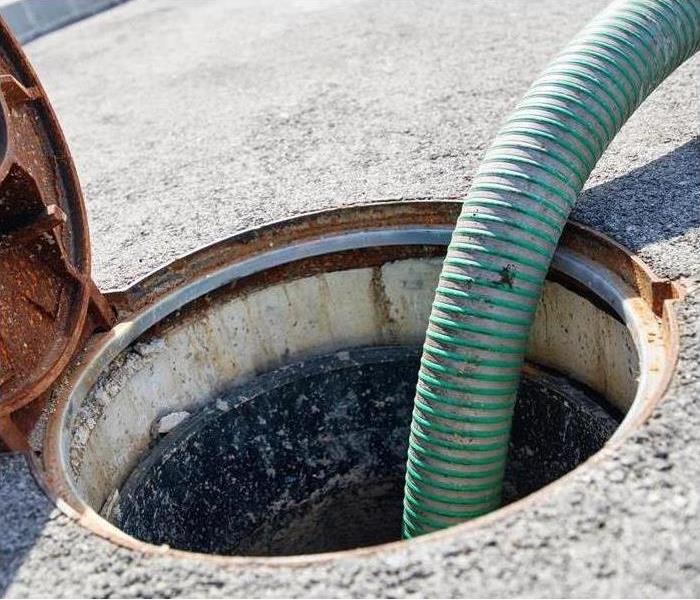 Sewage cleanup in Park City, UT.
Sewage cleanup in Park City, UT.
A sewer backup may be one of the most damaging problems with which you have to deal as a business owner or manager in Park City, UT. Not only is it a disgusting process, but you must also keep employees and customers safe from exposure to germs and chemicals. There are specific steps to keep everyone and your building as safe as possible during sewage cleanup.
Safety Steps For Sewage Cleanup
- Protect Yourself Against Various Hazards
First, it's essential to protect yourself by wearing personal protective equipment. Available PPE includes hair covers, safety goggles, respirators, rubber gloves, coveralls and waterproof shoe covers. Most of this gear can be bought in disposable form to better prevent cross-contamination. The amount of PPE necessary depends on the severity of the sewage. However, if there is a question, more is better than less.
Also, do not walk into any standing water where electrical components are plugged in. You will need to shut off the power to the area because an electrical current can pass through the water. Merely stepping a foot into the room could be extremely hazardous. If you can't safely navigate to the breaker box, call the power company or experienced electrician to turn the electricity off before you take any further action.
- Try Unclogging the Blockage
Next, you must unclog the sewer blockage and stop any running water. Shut off the water supply at the source or opt for the entire building. It could take the work of professionals if the backup is down the line a bit. If you have a flooded toilet, you can use a plunger or drain snake to unclog it yourself.
- Extract All Standing Water
Sewage water contains various bacteria and other contaminants that can quickly spread. During the sewage cleanup process, it's essential to extract the standing water as soon as possible. Standing water can also damage fast, so time is of the essence. If you decide to conquer the task yourself, a wet/dry vacuum can efficiently remove the water and smaller debris.
- Dry the Area and Contents
Once you have extracted all of the standing water, it's time to dry everything in the affected area as quickly as possible. This could mean tearing out water-damaged flooring (carpet will probably be ruined) and even some drywall. You may also need to remove most if not all of your contents from the area to dry them outside and to thoroughly clean them and the affected area.
You can use fans, heaters and fresh air to dry everything. Water damage restoration professionals can dry an area faster with industrial-grade fans and other equipment.
- Sanitize the Area and Contents
Finally, everything must be thoroughly cleaned and sanitized. Be sure to get into tiny spaces, even walls and furniture that have come in contact with the water and contaminants. After experiencing a flooded toilet or another type of sewer backup, performing a thorough sewage cleanup is critical. This can be a very labor-intensive job, even for a small amount of standing water. However, taking time to go through each of these steps can keep everyone safe and prevent avoidable damage to your building and its contents.
5 Things To Teach Your Kids About Fire Safety
4/1/2024 (Permalink)
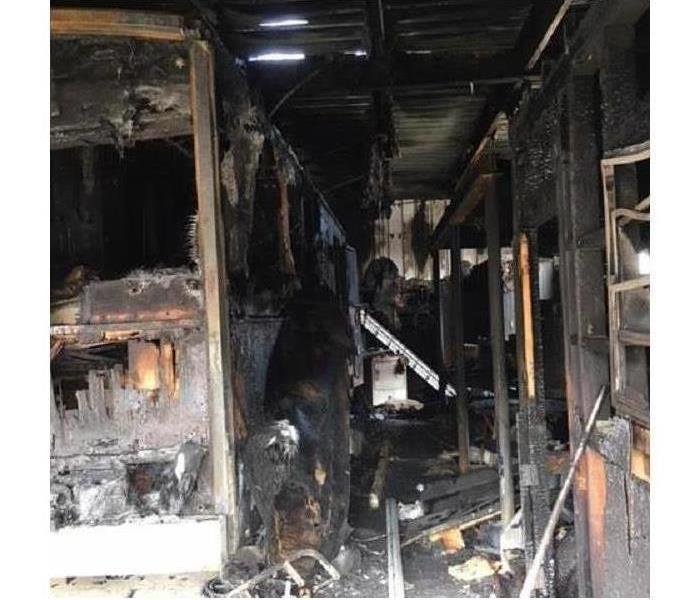 Fire damaged storage in Salt Lake City, UT.
Fire damaged storage in Salt Lake City, UT.
Teaching kids safety is an important factor when making an emergency fire plan for your Salt Lake City, UT, home. One way you can help protect them is by instructing them what to do if a fire does occur. Many firemen and fire damage restoration professionals agree that learning the following tips can help.
5 Lessons About Fire Safety
1.What Fire Hazards Are
One step toward preventing a home fire is to tell your children what a fire hazard is. This way they will know what items not to play with, and to tell you immediately if they see something amiss.
2. How To Stay Low
During a fire smoke and heat rise, meaning the cooler air is closer to the floor. Teaching your child to stay low can help them avoid the smoke and find fresher air.
3. How To Check a Door
One important step for kids safety during a fire is to know how to check a door before opening it. They should know to use the back of their hand to test the door’s surface for heat, and to open it only if it doesn’t seem hot.
4. What Safe Routes Are
Safe exit routes are an important part of a fire escape plan. Explain to your child where the closest exits are and how to use them safely.
5. Where to Meet Up
Instruct your child to go to a pre-selected location to meet up with you once they’re safely out of the house. This should be an easily identifiable location such as a neighbor’s porch or a fire hydrant.
In the event of a fire, kids' safety is important, and by teaching your child these things, you can feel more secure knowing they understand what to do in a fire. Telling them what a fire hazard is can help prevent a fire before it starts. They should also learn to stay low, check doors before they enter a room, follow safe routes out of the house, and where to meet up with everyone else.
How to Replace a Leaking Toilet
4/1/2024 (Permalink)
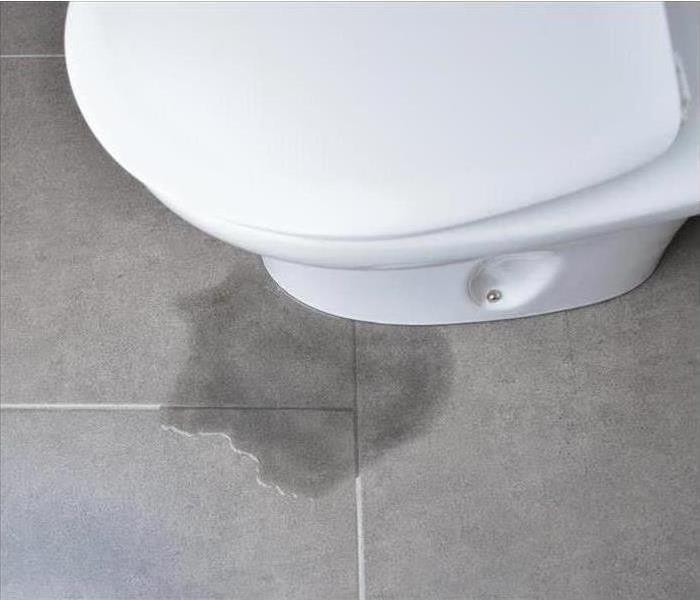 Leaking toilet in Salt Lake City, UT.
Leaking toilet in Salt Lake City, UT.
Although most commodes last for decades, they do need to be updated every now and then. If you have a leaking toilet in your home in Salt Lake City, UT, it might be time to replace it. Here are the steps to take to make this process as easy as possible.
3 Steps for Replacing a Leaking Toilet
1. Disconnect the Water Supply
Whether you are doing a toilet repair or installing a new one, never try to do work on a leaking toilet without disconnecting the water supply. This can lead to a large amount of standing water in your bathroom. In order to disconnect the water-supply tube you must loosen the compression nut on the shutoff valve.
2. Remove the Old Toilet
Depending on how long the old toilet has been in place, it may be stuck to the flooring. In order to remove it, you will need to unscrew any bolts and then gently rock it back and forth until it comes off the floor. Typically, there is a wax seal holding it in place, so you will need to break this before it will come off completely. If you are having trouble removing it yourself, you may want to call a professional to come help.
3. Install the New Toilet
Before you install the new toilet, you will need to get the area cleaned up, and remove any excess wax from the gasket. When you put the new one in place, make sure it is properly aligned. You can then secure it with the bolts. Some people choose to use caulk around the base to protect against mold growth. You should check with your building department to see if this is required in your area.
If you feel uncomfortable replacing the leaking toilet yourself, you should consider calling a water damage company in Salt Lake City, UT, to help you. They may also be able to work with you on the cleanup and check the extent of the damage. This may prevent larger or future issues from occurring.
How to Prevent Mold Growth After Water Damage in Salt Lake City, UT
3/9/2024 (Permalink)
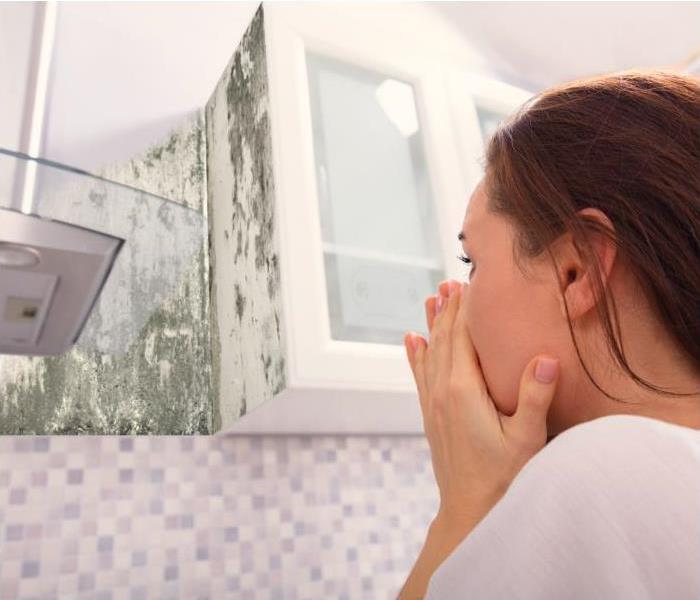 Prevent Mold Growth in Park City, UT
Prevent Mold Growth in Park City, UT
Water damage can be a homeowner's worst nightmare, and when it occurs, the risk of mold growth becomes a significant concern. Salt Lake City, UT, with its unique climate and topography, presents specific challenges when it comes to dealing with water damage and preventing mold. In this comprehensive guide, we'll explore effective strategies to safeguard your home and belongings from mold growth after water damage in the Salt Lake City area.
Understanding the Salt Lake City Climate:
Salt Lake City experiences a semi-arid climate with hot summers and cold winters. This climate variation can contribute to water damage through factors like heavy snowfall followed by rapid thaws, flash floods during summer storms, and occasional plumbing issues. These diverse scenarios require tailored approaches to prevent mold growth effectively.
Immediate Actions after Water Damage:
The first 24 to 48 hours are crucial when it comes to preventing mold growth after water damage. Quick and decisive actions can significantly impact the outcome. Here's a step-by-step guide on what to do immediately:
Safety First:
Ensure everyone's safety by turning off the electricity and gas supply to the affected area. If the water damage is extensive, it's advisable to evacuate until professionals deem the area safe.
Stop the Water Source:
Identify and stop the source of water leakage or flooding. This could be a burst pipe, a leaking roof, or flooding from heavy rains.
Remove Excess Water:
Use pumps, wet/dry vacuums, or buckets to remove standing water. The faster you can extract water, the less likely mold will have a chance to develop.
Ventilation:
Open windows and doors to facilitate air circulation. This helps in drying out the affected areas and preventing mold spores from settling.
Remove Wet Items:
Move wet furniture, carpets, and personal belongings to a dry area. Salvage what you can, and discard items that are beyond repair.
Use Dehumidifiers:
Deploy dehumidifiers to reduce the moisture levels in the air. Lower humidity inhibits mold growth, making it a crucial step in the prevention process.
Drying Out Your Home:
Once you've addressed the immediate concerns, the next step is to thoroughly dry out your home. In Salt Lake City, where cold winters can complicate the drying process, it's essential to be diligent in this phase:
Professional Drying Equipment:
Consider hiring professionals with industrial-grade drying equipment. These experts can ensure that even hard-to-reach areas are thoroughly dried, reducing the risk of mold growth.
Focus on Building Materials:
Pay special attention to structural elements like drywall, insulation, and wooden structures. These materials can retain moisture, providing an ideal environment for mold if not adequately dried.
Flooring Considerations:
Carpets, especially if saturated, can be a breeding ground for mold. If possible, remove and replace them. Hardwood floors may also need specialized drying techniques to prevent warping.
Inspection for Hidden Moisture:
Perform a thorough inspection to identify any hidden pockets of moisture. This may involve using moisture meters and infrared cameras to detect moisture behind walls or under flooring.
Preventing Mold Growth:
With the initial cleanup completed, it's time to implement preventive measures to ensure mold doesn't take hold. In Salt Lake City's climate, where humidity levels can vary, these steps are crucial:
Proper Ventilation:
Ensure that your home is adequately ventilated. Use exhaust fans in bathrooms and kitchens, and consider installing a whole-house ventilation system. Proper ventilation helps control humidity levels, reducing the likelihood of mold growth.
Monitor Humidity Levels:
Keep an eye on indoor humidity levels, especially during seasons with higher humidity. Aim for humidity levels between 30-50%. Use dehumidifiers if necessary.
Regular Inspections:
Perform regular inspections of your home, especially in vulnerable areas like basements and attics. Look for signs of water leaks, condensation, or dampness. Address any issues promptly.
Waterproofing:
Invest in waterproofing measures, such as sealing cracks in the foundation and walls. This can prevent water from seeping into your home, reducing the risk of future water damage.
Landscaping Considerations:
Ensure proper grading around your home to direct water away from the foundation. Keep gutters clean and in good condition to prevent water from overflowing and causing damage.
Proper Storage:
Store items in areas less prone to water damage. Elevate belongings in basements, use water-resistant storage containers, and avoid storing items directly on the floor.
Professional Assistance:
In some cases, especially with extensive water damage, seeking professional assistance is the best course of action. Professional restoration companies in Salt Lake City have the expertise and equipment to handle large-scale water damage effectively. They can conduct thorough assessments, provide a comprehensive plan for cleanup and drying, and offer preventive measures to safeguard against mold.
Water damage is a significant concern for homeowners in Salt Lake City, UT, given its unique climate and topographical challenges. However, with prompt action, thorough drying, and preventive measures, you can minimize the risk of mold growth and protect your home and belongings. By understanding the specific needs of your region and implementing the strategies outlined in this guide, you can navigate the aftermath of water damage with confidence, ensuring a safe and mold-free living environment for you and your family.
3 Steps To Stop a Toilet From Overflowing
9/8/2022 (Permalink)
 If you need to replace your toilet, contact a water damage mitigation and restoration company.
If you need to replace your toilet, contact a water damage mitigation and restoration company.
A drain line blockage can result in a flooded toilet. Homeowners can take three steps to stop a toilet from overflowing and limit the extent of sewer damage at a residence in Salt Lake City, UT.
Steps To Stop a Toilet From Overflowing
1. Contain Damage
Contaminated water can cause major water damage. If this water sinks into carpet or porous building materials such as drywall, these materials will likely need to be torn out and replaced. Use towels or a mop to stop the spread of sewage backup.
2. Use a Plunger or Snake
Once a homeowner has taken measures to try to stop the spread of sewer damage, he or she should address the cause of the problem. If the backup is due to a minor clog close to the floor drain, plunging a toilet may be enough to clear the clog and stop the overflow.
If the clog is more severe, insert an auger or snake into the toilet. Some augers have hand cranks while others can be attached to a power drill. It may be more effective to remove the toilet and snake the floor drain directly. You will need to use specialized tools and remove water from the bowl and tank or use a solidifying gel. Clear deeper clogs by snaking the drain cleanout in a basement or crawlspace.
3. Contact a Plumber
Calling a plumber can be easier than removing a toilet or dealing with a drain cleanout. If you do not have a snake or the skill or tools necessary to attempt advanced plumbing techniques, a trained professional is your best bet. If the problem originates in a municipal main, contact a sewage company.
If a flooded toilet causes extensive sewer damage, a homeowner should contact a water damage mitigation and restoration company located in Salt Lake City, UT. Experts can remove damaged materials, promote drying to prevent mold and restore the affected area.
3 Tips for Fixing a Flooded Basement
8/11/2022 (Permalink)
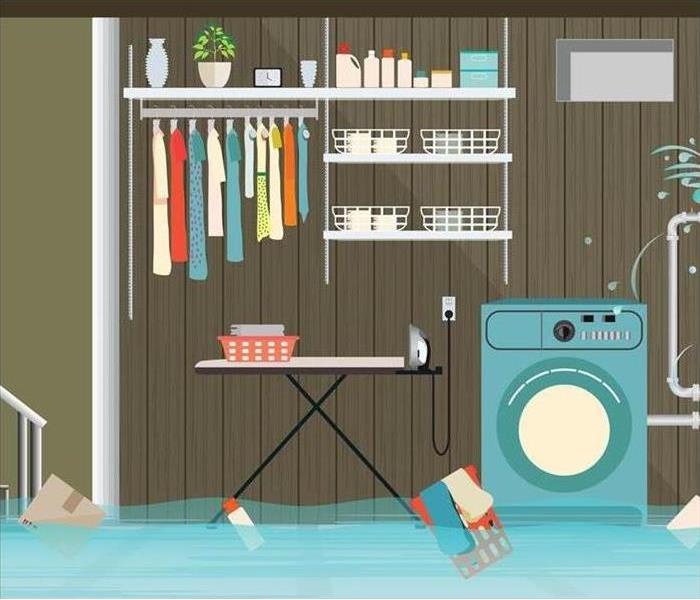 A flood in your basement can result in serious water damage.
A flood in your basement can result in serious water damage.
A basement flood can be a frustrating problem to deal with. If your home has a basement, it is important to familiarize yourself with what steps you can take to fix a flooded basement before a flood occurs. These three tips can help.
Tips for Fixing a Flooded Basement
- Remove the Water Before You Go in
Many basements have electrical appliances, wiring, and electrical panels that can create an electrocution hazard in a flooded basement. If you are dealing with a shallow flood, and you can access the service panel to turn off the electric circuits in the basement without going into the water, you may be able to remove the water using a hose from a shop vac on an upper floor. However, if the water level is above electrical outlets, it is best to call the fire department, rent a heavy-duty gas-engine pump or contact a water remediation company in Salt Lake City, UT, to assist you.
- Don't Try To Save Your Flooded Electrical Items and Appliances
The Gas Appliance Manufacturers Association and the National Electrical Manufacturers Association recommend replacing any mechanical or electrical equipment that has been exposed to a basement flood. Any fixtures, outlets, switches, wiring, electrical motors or appliances that have been exposed to flood water should be removed and discarded, rather than repaired. Check with your insurance professional if you need clarification about whether your insurance coverage will cover replacement versus repair costs for damaged items.
- Take Preventative Measures
Once you get your basement restored, take steps to prevent flooding from occurring again. Adding foundation drains, a generator to keep your sump pump operating during a power outage or a backup sump pump can help keep water out of your basement.
A basement flood can result in serious water damage to your home. These three tips can help you restore your home to preloss condition and prevent future problems from occurring.





 24/7 Emergency Service
24/7 Emergency Service









